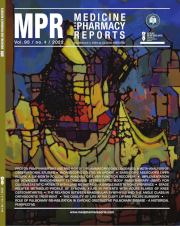Current approaches in management of patients with keratoconus
DOI:
https://doi.org/10.15386/mpr-2197Keywords:
keratoconus, corneal cross-linking, intracorneal ring segments, deep anterior lamellar keratoplasty, penetrating keratoplastyAbstract
Keratoconus is a relatively frequent eye disease, especially in young patients, in which the cornea gradually thins and deforms in a cone shape. In the past, it could be treated only with glasses, rigid contact lenses or, for advanced cases, penetrating corneal transplant. Nowadays, corneal cross-linking, intracorneal ring segments implantation or deep anterior lamellar keratoplasty are available options of treatment, along with the above mentioned ones. Several studies focused on this disease and its management attempted to establish the applicability of these treatment methods in current practice. In the early stages, glasses or soft toric contact lenses are able to correct the astigmatism, but, as the disease progresses, rigid contact lenses are indicated. Corneal cross-linking is done in order to slow down or even stop the progression of the disease. Implanting intracorneal ring segments helps improve visual acuity in patients with low vision that cannot be corrected otherwise. Advanced stages need corneal transplant, either penetrating or anterior lamellar, depending on each patient’s ocular characteristics. Thus, keratoconus treatment is individualized for every patient, according to the stage of the disease. Moreover, because of the new developed technology, keratoconus patients can benefit from efficient treatment, in much safer conditions.
Downloads
Published
How to Cite
Issue
Section
License
The authors are required to transfer the copyright of the published paper to the journal. This is done by agreeing to sign the Copyright Assignment Form. Whenever the case, authors are also required to send permissions to reproduce material (such as illustrations) from the copyright holder.

The papers published in the journal are licensed under a Creative Commons Attribution-NonCommercial-NoDerivatives 4.0 International License.

